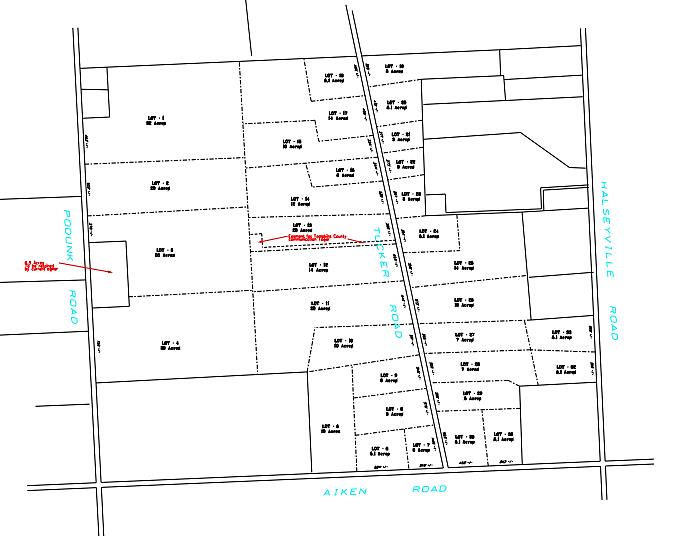by Robert Lynch, January 7, 2023
The shock wave may have passed. But now the heavy lifting begins.
The New Year’s first meeting of the Enfield Town Planning Board Wednesday brought with it far less surprise than did its last meeting of 2022, the session when neighbors grabbed nearly every seat in the room to learn more—and voice concern—about the suddenly-sprung subdivision that alarmed them; Land & Lakes Development’s proposed “Breezy Meadows Farm” 33-large lot subdivide of a nearly 340-acre tract between Halseyville and Podunk Roads. Anonymously-circulated flyers placed in mailboxes in early-December had first warned neighbors of the developer’s plans.

But now, one month later, the dust of controversy has settled a bit, as Enfield planners launched their laborious, multi-meeting review of developers’ plans that remain very much in the incubation stage.
And maybe “incubation” is an apt term of art. The Breezy Meadows tract would include the long-abandoned Babcock Hatchery poultry barns east of Podunk Road. The barns were subsequently, briefly used to raise swine. But all are now vacant. A few have junk in them, and others are simply falling in.
“This is a big project, and it’s going to be important to the people of the Town for many, many years,” Enfield Planning Board member Mike Carpenter told fellow planners at the January 4th “sketch plan conference” with Land & Lakes’ officials.
The conference became the Planning Board’s earliest round of detailed review. Planners raised questions for nearly an hour and a half. Land & Lakes Project Manager Alan Lord provided the answers. Fittingly, they were sketchy as well. Lord must still survey the lots. The Planning Board expects to review a “preliminary plat” of the development in March. The Board’s timetable would delay a Public Hearing on Breezy Meadows until April at the earliest.
Whether neighbors preferred to bide their time, or simply lacked knowledge of Wednesday’s meeting, few turned out for the Breezy Meadows’ discussion this time. Only about a half-dozen attended. A few asked questions, yet they stopped short of voicing outright opposition.
So Board members took the lead. For some, Tucker Road became a concern. A lightly-traveled gravel crossway that would slice through the development, Tucker has only a handful of houses bordering it now. But Breezy Meadows, as it’s now sketched, would front nearly two dozen lots on the road.
“There’s issues with the road,” Planning Board Chair Dan Walker said, relaying a recent appraisal by Enfield Highway Superintendent Barry “Buddy” Rollins, who did not attend Wednesday’s meeting. “It’s not a very stable road when it’s wet,” Walker quoted Rollins as saying. Walker agreed. “There’s going to be impact on the road, ” the Board Chair said.
The Breezy Meadows sketch map stuck in mailboxes a month ago had depicted lot lines quite precisely chopping up the former farm, now owned by the John William Kenney Revocable Trust. Expect those initial boundaries to remain quite the same as first drawn, even after surveyors complete their work.
“There’s not a real good way to move the subdivision around,” Alan Lord told Enfield planners. Lord has tried to keep lot lines traveling existing hedgerows as much as possible, though the attempt limits flexibility. The current layout would place the largest lots on the development’s west side, where the former Babcock barns stand. Lot sizes throughout would range from three acres to as large as 32.
“We will be investigating the buildings,” the project manager assured the Planning Board concerning the Babcock barns. “I hope somebody would use those.”
Yet, in some instances, future use could prove a problem. Walking through the brushy, overgrown site last month (before its owners’ representatives evicted him), this writer observed roofs had fallen in on several structures, and many barns stood in a decades-long state of disrepair.
It’s possible Planning Board approval might hinge on barn demolition. And there could be further demands that allow only the right kinds of animals be raised in the barns that survive.
They could be used for “raising chickens again,” Walker recommended to the Board. “I don’t think we want anybody raising pork again.”
****
But by far, the majority of Planning Board discussion Wednesday centered about a model deed covenant that Land & Lakes purportedly would attach to every property it sells. And the ensuing discussion charted a circumlocutory path toward a new breed of land use control in un-zoned Enfield.
“You are potentially zoning the Town of Enfield in the lots you’ve sold,” Board member Carpenter observed as he viewed the proposed covenants. It’s “zoning through the back door.”
Nonetheless, Carpenter cautioned, “I’m a little iffy about doing partial zoning in the Town of Enfield.”

And Dan Walker then offered his own opinion. “I don’t think a majority of those in the Town of Enfield want zoning,” he said.
Alan Lord admitted that the proposed deed restrictions he shared with Enfield Planners were cut-and-pasted from a Dryden tract his firm recently subdivided, a 42-lot, 900-acre project, still largely unsold, but situated in a more tightly-regulated community.
The proposed Breezy Meadows covenant adapted from Dryden would, among its 18 restrictive paragraphs, prohibit “single wide manufactured homes.” It would bar purchasers from further subdividing their lots, restrict camping trailers to a 90-day stay, and require the buyer to maintain the purchased lot “in a good and sanitary condition.”
One of the Dryden project’s more intrusive rules would keep outdoor lighting “to a minimum,” and where necessary, direct light to the ground. Lord said those in Dryden wanted “to protect the night sky.”
Rules are good, planners acknowledged. But who enforces them once they’re written? And can the Town of Enfield, itself, undertake enforcement?
Apparently, it cannot. In an advisory opinion Town Supervisor Stephanie Redmond promptly secured from legal counsel, the attorney advised Enfield officials that while private parties can enforce deed covenants in court, governments generally lack the authority to do so.
“We want to protect values and our reputations,” Alan Lord told the Planning Board, indicating that Land & Lakes might enforce its own covenants, though its Managing Partner, Bob Lesperence, also attending Wednesday’s meeting, said enforcement generally comes through informal contact, not court action.
And while New York State, Land & Lakes, or another subdivision purchaser could initiate litigation, a “neighbor across the street” could not, Board members were told.
Mike Carpenter generally liked the covenant-based restrictions Land & Lakes put forth. Yet Carpenter wondered whether Lord’s firm could reach beyond what it’s written.
What about an energy efficiency clause, Carpenter suggested; one that would set an efficiency standard one step beyond the state’s building code? “I’d like to encourage better housing to be built,” Carpenter explained.
Expect more discussions about Breezy Meadows in March.
###

